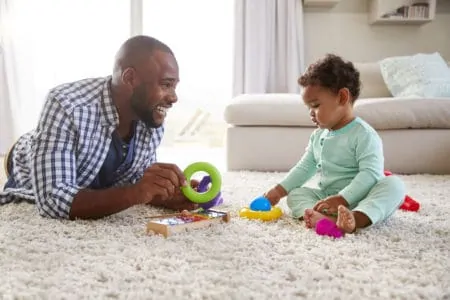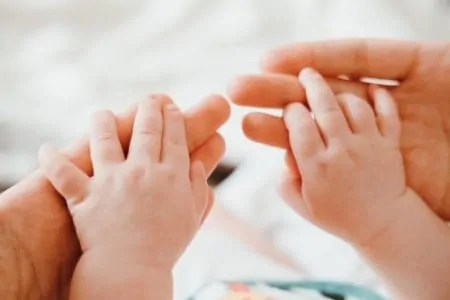Watching a baby discover they can move on their own is a massive milestone. One minute they are sitting still, and the next, they are mobile. Parents often ask, “When do babies crawl?” While it varies, it usually happens midway through the first year.
Since every infant develops on their own timeline, there is no single date for this skill. Some start early, while others might skip it entirely. We will break down the timeline, the different styles of movement, and how to keep your little explorer safe.
Key Takeaways
- Average age: Most babies begin to crawl between 7 and 10 months old.
- Styles vary: Techniques include the classic crawl, belly (commando) crawl, scooting, and bear crawling.
- Development: Tummy time and floor play are the best ways to build the core strength needed for movement.
- Skipping it: Some babies bypass crawling and go straight to pulling up, cruising, and walking.
At What Age Do Babies Crawl?
Babies typically start to crawl between 7 and 10 months of age (1). If your 10-month-old isn’t moving yet, take a deep breath; they might just be taking their time.
In the early stages, your baby might look like a little soldier. This “commando crawl” usually involves dragging the belly across the floor using the forearms. Once their legs get stronger and catch up to the arms, they often lift their tummies off the floor.
It is important to remember that siblings, and even twins, may use completely different methods. Some scoot, some roll, and some look like crabs.
1. The Classic Crawl
This is the style most people picture. The baby is up on all fours, distributing weight between their hands and knees. They move one arm and the opposite leg simultaneously to propel forward. This cross-lateral movement is excellent for balance and coordination, but it is not the only “correct” way to move.
2. The Belly (Commando) Crawl
Also known as the army crawl, this is a very common starting point. Your baby keeps their tummy against the floor and drags themselves forward using their forearms. The legs usually drag behind or wiggle without providing much push.
3. The Rolling Crawl
While not technically crawling, rolling is a legitimate form of transportation for many infants. This usually starts after 6 months once the core muscles are strong enough to flip from back to belly (2).
I call this “rolling to navigate.” If your baby uses this method, keep a close eye on them; they can roll across a room, or off a bed, faster than you might expect.
4. The Bear Crawl
This is a fun variation where the baby keeps their elbows and knees straight, walking on hands and feet like a bear. It looks a bit like the yoga “downward dog” position in motion. It requires a lot of hamstring flexibility and upper body strength.
5. The Bottom Scoot
Some babies prefer to sit upright and shuffle across the floor. They use their arms to pull themselves forward or push off with their legs while sliding on their bottom. It looks quirky, but bottom scooters can be surprisingly fast.
6. The Crab Crawl
This style looks like a baby is trying to figure out the mechanics of movement in reverse. They might push with their hands and end up moving backward or sideways. One leg might tuck under while the other extends. It is usually a transitional phase before they figure out forward motion.
How Do Babies Learn to Crawl?
Crawling is a major workout that requires both physical strength and brainpower. Before movement happens, your baby needs to strengthen their neck, shoulders, core, and arms. These muscles act as the chassis that supports their weight.
Did You Know
Binocular vision allows the brain to combine images from both eyes to create depth perception. This helps your baby judge how far away a toy is. They constantly switch focus between their hands and the destination, which gives their brain a serious workout (4).
Once they start moving, they build a mental map of your home. You will notice they start recognizing routes, like how to get around the coffee table to reach the dog’s water bowl.
Most babies start by rocking back and forth on their hands and knees. This “rocking” phase is the precursor to forward motion. It might involve a few face-plants, but that is part of the learning process. By 9 or 10 months, many babies figure out how to coordinate their limbs for speed.
How You Can Help Your Baby
1. Prioritize Tummy Time
Tummy time is the single most effective exercise for pre-crawlers. Placing your baby on their belly helps them lift their head and push up with their arms, strengthening the muscles required for crawling (5).
Try to do this when your baby is alert and happy. Even a few minutes at a time makes a difference.
For infants who seem to dislike tummy time, I recommend doing it for only 1 minute but more frequently throughout the day. For example, I recommend one minute of tummy time after each diaper change.Most infants need their diapers changed at least 6 times a day, so coordinating tummy time with this task increases their opportunity to practice it. Limiting the time frame to one minute prevents babies from tiring too quickly.
Editor's Note:
Dr. Leah Alexander, MD, FAAPAlways supervise tummy time to ensure their airway remains clear. Use a blanket, low-pile carpet, or a specialized play mat for comfort.
This practice also prevents the back of the head from flattening (plagiocephaly). Since the “Back to Sleep” campaign began in 1994 to reduce SIDS, babies spend more time on their backs (6). Tummy time counteracts this and encourages motor skills.
2. Use Motivation
Babies are naturally curious. If they see something they want, they will try to get to it. Place a favorite toy, a remote control, or a mirror just out of reach during tummy time.
This frustration, in small doses, is a great motivator. As they get better at moving, you can create “obstacle courses” using pillows and cushions. This improves agility and confidence.
Crawl tunnels are another fantastic tool. They make the act of moving from A to B an adventure. Just stay close by; tunnels and pillows can be hazardous if a baby gets stuck.
3. Practice Standing and Sitting
Assisted standing helps wake up the leg muscles. Hold your baby under their arms and let them bear some weight on their feet. Most infants can do this with support by 3 or 4 months (7).
Learning to sit independently is another key step. It engages the core and back muscles. If your baby is wobbly, place a nursing pillow behind them for safety. Sit on the floor with them and play peekaboo to encourage them to stay upright longer.
Is Childproofing Necessary?
Yes, childproofing is absolutely necessary. A crawling baby sees the world from a floor-level perspective, which reveals dangers you might miss (8).
I discuss childproofing at the 6-month well visit. At this stage, most babies have mastered rolling and will start to move from where their parents have left them. The easiest way to find potential hazards is for parents to crawl around themselves, looking for what their baby may get into. Anything that could be dangerous for a baby should be moved or covered with a protective device.
Editor's Note:
Dr. Leah Alexander, MD, FAAPHere are the critical areas to secure:
- Stairs: Install safety gates at the top and bottom of all staircases. Stairs are a magnet for babies but are extremely dangerous until they master walking.
- Small Objects: Get down on your hands and knees to scan for coins, paper clips, or small toy parts that could be choking hazards.
- Chemicals: Lock away all cleaning supplies and detergents.
- Electricity: Cover all power outlets and secure dangling cords that a baby could pull on.
- Furniture: Anchor heavy furniture, like bookshelves and dressers, to the wall so they cannot tip over.
What Happens After Crawling?
Once your baby masters all fours, they will look for vertical challenges. The next natural step is “pulling to stand.” You will likely find them gripping the crib rails or using your pant leg to hoist themselves up.
When they start pulling up, lower the crib mattress immediately to prevent them from falling out.
From standing, they will progress to “cruising.” This is when they shuffle sideways while holding onto furniture like the couch or coffee table. Cruising builds the balance and confidence needed to let go and take those first independent steps.
Hold The Shoes
What If My Baby Doesn’t Crawl?
It can be stressful if your baby doesn’t crawl when their peers do. However, crawling is not actually a required developmental milestone on some medical charts. Many healthy babies skip it entirely (10).
Some infants go from sitting to scooting, then straight to pulling up and walking. In my practice, roughly 30% of infants do not perform the “classic” crawl. This is especially common if they have older siblings they want to keep up with; walking is faster than crawling.
However, keep an eye on symmetry. If your baby drags one side of their body while crawling or seems to only use one arm, mention it to your pediatrician.
By 9 months, your doctor will check if your baby bears weight on their legs (11). If your baby feels “floppy” or refuses to put feet down when supported, further investigation might be needed to rule out muscle tone issues.
I have some parents in my practice who complain of grandparents telling them it is “unsafe” to do such leg weight-bearing activities. They believe it will injure the baby’s back in some way. This belief is not medically accurate. Holding a baby upright for weight-bearing on the legs is important for normal development and making progress in milestones.
Editor's Note:
Dr. Leah Alexander, MD, FAAPTrust your gut. If you feel their development is significantly delayed, a quick check-in with a doctor can provide peace of mind.
FAQs
Crawling Is Fun
This is an exciting, chaotic time for your family. While most babies get moving between 7 and 10 months, try not to obsess over the calendar. Whether they bear crawl, crab walk, or bottom scoot, the important thing is that they are coordinating their body to explore the world.
If your baby decides to skip crawling and walk instead, that is okay too. Just make sure you have those safety gates installed, once they start moving, they don’t stop!













